
About UsThe Numismatic Bibliomania Society is a non-profit organization promoting numismatic literature. For more information please see our web site at coinbooks.org SubscriptionsThose wishing to become new E-Sylum subscribers (or wishing to Unsubscribe) can go to the following web page link MembershipThere is a membership application available on the web site Membership Application To join, print the application and return it with your check to the address printed on the application. Membership is only $15 to addresses in the U.S., $20 for First Class mail, and $25 elsewhere. For those without web access, write to: David M. Sundman, Treasurer AsylumFor Asylum mailing address changes and other membership questions, contact David at this email address: dsundman@LittletonCoin.com SubmissionsTo submit items for publication in The E-Sylum, just Reply to this message, or write to the Editor at this address: whomren@gmail.com
BUY THE BOOK BEFORE THE COIN |
- WAYNE'S WORDS: THE E-SYLUM JUNE 30, 2013
- NEWMAN COLLECTION SPECIAL HARDCOVER EDITION AVAILABLE
- NEW BOOK: 2014 STANDARD CATALOG OF WORLD COINS 2001-DATE
- NEW BOOK: CASH IN YOUR COINS
- NEW BOOK: GENERAL CATALOGUE OF BRAZILIAN TOKENS ADDENDUM
- NEW BOOK: THREE CONFERENCES ON INTERNATIONAL MONETARY HISTORY
- NEW BOOK: GOLD IS THE KEY
- BOOK REVIEW: MONEY: THE UNAUTHORISED BIOGRAPHY
- THE ERRORSCOPE JULY/AUGUST 2013 ISSUE PUBLISHED
- NEW YORK MANSION TO HOST NEWMAN II SALE
- HARVEY STACK ON FORD, FRANKLIN, AND FALSE GOLD
- NOTES FROM E-SYLUM READERS: JUNE 30, 2013
- MORE ON VIRGIL MCKNIGHT HANKS, JR.
- NATIONAL MARITIME MUSEUM MERCATOR MAP MEDALS
- DORR & BREWSTER INFORMATION FOUND
- QUERY: PAPERS OF CHIEF ENGRAVER WILLIAM KNEASS SOUGHT
- AUCTION BIDDING: STAY IN THE ROOM
- A WWII AVIATION SHORT SNORTER
- LEAD COUNTERFEITS, MAGNETS AND MAKING ELECTROTYPES
- SOME NEW COIN DESIGNS: JUNE 30, 2013
- PROTESTS DRIVE BANK OF ENGLAND TO JANE AUSTEN
- BANKNOTES COOLER THAN THE BORING AMERICAN DOLLAR
- SAINT-GAUDENS DIANA STATUE TO BE REGILDED
- FEATURED WEB PAGE: LITHUANIAN COINS OF THE 1920S
WAYNE'S WORDS: THE E-SYLUM JUNE 30, 2013

New subscribers this week include Daryl Haynor. We have 1,656 email subscribers, plus 234 followers on Facebook.
AOL subscribers are still reporting problems with not receiving their email issue. In most cases their address is still on our mailing list, but their mail isn't being delivered to their inbox by AOL - it's getting marked as spam somewhere along the way.
Our email provider Binhost merged into a company called Capalon some time ago, and a few weeks ago they migrated the mail system to new servers. AOL hasn't caught up with the change yet.
Hotmail may be having the same problem. I checked with the Capalon folks, and here are the IP addresses you can ask your email provider to whitelist:
204.9.143.105
204.9.143.108
204.9.143.131
204.9.139.0/24
But most other subscribers got the recent issue without problems. Bob Evans writes:
I'm assuming from Monday morning's test that you are still experiencing some issues with the delivery of The E-Sylum to all subscribers. I am assuming also that you hear mostly from the disgruntled, and so you are the recipient of a biased sample. So I take the opportunity here to inform you that I have NOT experienced ANY problems with E-Sylum delivery, display, or any other issues (except for times I seem to recall when it was delayed by human factors.) I receive it through my gmail account and on my MacBook Pro without any difficulties. As far as I am concerned, keep up the good work!
This week we open with word on the Newman sale hardcover catalogs, and reports on five new numismatic books. Other topics include the venue for the Newman II sale, book reviews, V. M. Hanks, Jr., the papers of William Kneass and portraits on Bank of England notes.
To learn more about Brazilian tokens, the Bhutanese ngultrum, a three – piece bonded broadstruck triplet error, the National Maritime Museum, the Hammer Museum, muddle-headed economists and philosophers and The Detective and the Somnambulist, read on. Have a great week, everyone!
Wayne Homren
Editor, The E-Sylum
NEWMAN COLLECTION SPECIAL HARDCOVER EDITION AVAILABLE
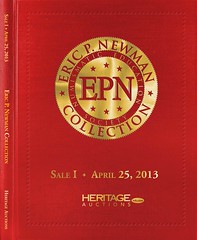 Kolbe & Fanning Numismatic Booksellers are pleased to announce that they have received the special edition hardcovers for the first sale of material from the Eric P. Newman Numismatic Education Society (EPNNES) collection. Copies have been sent to advance subscribers. This first sale was the April 25, 2013 auction of pattern coins offered by Heritage Auctions.
Kolbe & Fanning Numismatic Booksellers are pleased to announce that they have received the special edition hardcovers for the first sale of material from the Eric P. Newman Numismatic Education Society (EPNNES) collection. Copies have been sent to advance subscribers. This first sale was the April 25, 2013 auction of pattern coins offered by Heritage Auctions.
The response to the original call for subscribers was strong, but there are a small number of additional subscriptions that can be filled. Please contact Kolbe & Fanning today to subscribe.
Each special edition hardcover catalogue is professionally and attractively bound in uniform style. Subscribers to the entire series will be able to purchase each special edition catalogue for $95 plus $5 shipping in the United States (customers outside the U.S. will pay $95 plus the actual cost of foreign postage). Customers wishing to purchase only a particular sale will be able to do so for $120 plus postage while supplies are available. It is expected, however, that most of the available catalogues will be reserved for subscribers to the series.
The Eric P. Newman Numismatic Education Society will receive $25 from the sale of every catalogue to further its philanthropic activities, including the advancement of numismatic scholarship.
To subscribe to the special edition hardcover catalogues of the Eric P. Newman Numismatic Education Society sales, please visit the Kolbe & Fanning website at www.numislit.com, where orders may be securely placed by credit card. You may also contact David Fanning to place subscription orders at (614) 414-0855 or via email at df@numislit.com.
NEW BOOK: 2014 STANDARD CATALOG OF WORLD COINS 2001-DATE
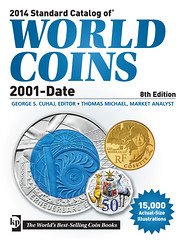 The only book on the market focusing on world coins released in the 21st century, the 2014 Standard Catalog of World Coins 2001-Date is now available from Krause Publications.
The only book on the market focusing on world coins released in the 21st century, the 2014 Standard Catalog of World Coins 2001-Date is now available from Krause Publications.
The eighth edition of this Standard Catalog comes in at 1,008 pages, about 100 pages more than the seventh edition.
Editors Tom Michael and George Cuhaj work with a worldwide network of more than 100 experts to provide the latest market values in five grades. In addition to more than several hundred thousand accurate values, the Standard Catalog features 12,500 quality images and hundreds of new and/or improved images for easy identification.
Collector coins, sets, trial strikes, Pieforts, patterns, token issues and more are included in this Standard Catalog.
For more information visit www.sellcoinbooks.com/world-coin-books/2014-standard-catalog-of-world-coins-2001-date.
Editor George S. Cuhaj is a 18-year veteran of Krause Publications' Numismatic Catalog Division, where he is also the editor of the Standard Catalog of® World Coins series. Cuhaj hails from New York City, where he was previously on staff with the American Numismatic Society, Stack's Rare Coins and R.M. Smythe & Co. He is a frequent instructor at the American Numismatic Association's Summer Seminars. Market Analyst Tom Michael serves as market analyst for Krause Publications coin catalogs, and has done so for nearly 100 world and U.S. coin catalogs. He has more than 20 years of experience researching and reporting on world coin prices and market trends.
For more information, see: www.sellcoinbooks.com/world-coin-books/2014-standard-catalog-of-world-coins-2001-date
NEW BOOK: CASH IN YOUR COINS
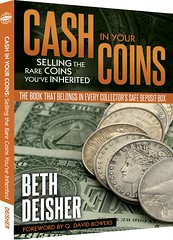 Whitman Publishing announces the release of Cash In Your Coins: Selling
the Rare Coins You’ve Inherited, by Beth Deisher. The 288-page book is available online
(including at www.Whitman.com) and from book sellers and hobby shops nationwide, for $9.95.
Whitman Publishing announces the release of Cash In Your Coins: Selling
the Rare Coins You’ve Inherited, by Beth Deisher. The 288-page book is available online
(including at www.Whitman.com) and from book sellers and hobby shops nationwide, for $9.95.
Deisher wrote Cash In Your Coins to inform and protect the hundreds of thousands of Americans who already collect coins, and those who will someday inherit their collections.
Coin collecting is a popular national pastime, recently invigorated by the U.S. Mint’s State quarter program. (Today the Mint regularly sends its catalogs to more than 600,000 active collectors.) The hobby’s popularity is not new: Whitman Publishing has sold more than 23 million copies of its annual Guide Book of United States Coins (the “Red Book”) since 1946.
Valuable coins might be archived in safe-deposit boxes; they could be tucked away in Grandpa’s cigar box. They might compose a carefully arranged collection—or sit jumbled in a disorganized hoard. Cash In Your Coins answers questions that inheritors often ask: “How rare are these coins? What are they worth? Should we sell? Where would we even begin?”
Author Beth Deisher is an award-winning journalist and retired editor of Coin World, the premier news weekly for collectors. For more than 30 years she has answered the questions above. Now, in Cash In Your Coins, she guides readers through the process of making sense of their coins, and making smart decisions when they sell.
Q. David Bowers (research editor of the Red Book) says, “With Beth Deisher’s guidance you’ll avoid costly mistakes and make decisions about your coins with more confidence.”
In addition to giving confidence to tomorrow’s inheritors, Cash In Your Coins gives comfort to today’s collectors. They can keep a copy of the book alongside their collection, knowing it will be there to give their heirs profitable knowledge and advice.
Cash In Your Coins • ISBN 0794837921 • Softcover • 6 x 9 inches • Full color • 288 pages • Retail $9.95
Sorting, identifying, inventorying and valuing coins are all covered in an easy and understandable way. The tips are very practical, particularly for the typical accumulation most heirs encounter. For example, sorting coins by color, which is an easy step for isolating the more valuable silver and gold coins. To handle piles of Wheat Cents, she recommends weighing them, a good practical alternative to individually evaluating what could be hundreds or thousands of common coins.
I found the section on calculating melt value very helpful. Some readers will get lost in the math, but ought to have a very good incentive for figuring it out in order to get a fair price for their junk bullion coins. At $9.95. the book is quite affordable and a bargain for the right readers, who could save a hundred times that amount by following its advice and avoiding a disposition disaster. -Editor
Dennis Tucker adds:
I've talked to a lot of dealers and collectors this week (I'm at the ANA Summer Seminar; Beth and I are teaching a course on writing, editing, research, collecting, and numismatic publishing, along with Ken Bressett and Bob Hoge), and it's been gratifying to hear "I'm so glad Beth wrote this book" over and over.
Collectors' widows, children, and other heirs are one obvious audience for "Cash In Your Coins." But equally I feel it's a book for COLLECTORS themselves --- not necessarily to learn about the latest VAMs or American Silver Eagle sets, but to keep in the safe-deposit box along with their collections. It's peace of mind for them, knowing that Beth Deisher will guide their families when the time comes. "The widow game," is how one dealer summarized the treatment dished out by unscrupulous hotel-ballroom buyers and other fleece artists. Beth has given the widows a way to fight back!
We've also heard from longtime dealers and collectors who like having a single resource that explains capital gains, insurance, declarations of value in an estate inventory, the effects of recent legislation, etc. Two examples: the American Taxpayer Relief Act of 2012 set new tax rates and thresholds that affect collectors; and "ObamaCare" imposes a 3.8% tax that goes into effect December 31 of this year. Not surprisingly, many collectors aren't up to date on this kind of legislation. Beth explains it all with the skill and clarity of a longtime journalist.

NEW BOOK: GENERAL CATALOGUE OF BRAZILIAN TOKENS ADDENDUM
By the end of September 2013 I will publish the Addendum to the General Catalogue of Brazilian Tokens, which appeared in 2009 and is now out of print. As with the Catalogue, the Addendum will be bilingual Portuguese-English and will contain about 500 new Brazilian tokens, which were brought to my attention after the publication of the Catalogue.
The edition will be limited to 200 signed copies and will contain information on rarity, prices, etc. Colour photographs of the tokens will be included, along with their description and attribution.
NEW BOOK: THREE CONFERENCES ON INTERNATIONAL MONETARY HISTORY
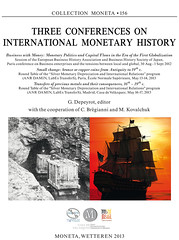 I am pleased to inform you that the proceedings of the two round tables in Paris (13-14 May 2013) and at the Casa de Velázquez (Madrid, 16-17 May
2013) are published.
I am pleased to inform you that the proceedings of the two round tables in Paris (13-14 May 2013) and at the Casa de Velázquez (Madrid, 16-17 May
2013) are published.
Paris: Small change: bronze or copper coins from Antiquity to 19th c.
Madrid: Transfers of precious metals and their consequences, 16th – 19th c.
The volume also includes the 2012 Paris conference: Business with Money: Monetary Politics and Capital Flows in the Era of the First Globalization, Session of the European Business History Association and Business History Society of Japan, Paris conference on Business enterprises and the tensions between local and global, 30 Aug - 1 Sept 2012
For more information, see: www.moneta.be/volumes/moneta_156.htm
NEW BOOK: GOLD IS THE KEY
Many of these have large cuts in an "X" shape. It turns out that there was a special tool for this. It was a very simple tool - a hammer called the cancelling hammer. Rather than a flat end for hammering nails, it had an X shape, and with one whack a clerk could cancel a bill or small stack of bills.
Editor Fred Reed kindly supplied me with the following text and image excerpted from the article. It concerns a book about a crime in Jackson, TN involving a bank hammer as a murder weapon. See the book's cover for an illustration of a (bloodied) bank hammer. Thanks! -Editor
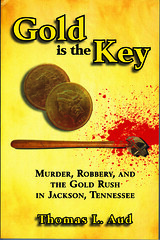 A magazine article made passing mention of Carl Bolt, an antique tool collector in Oroville, CA. His museum is recognized as the largest documented antique tool collection in the United States. Although he does not have a bank hammer, he referred me to The Hammer Museum in Haines, Alaska (www.hammermuseum.org). They retain an example close in size to the one at Lee Valley Tools. Their curator, Dave Pahl, informed me that a book had been written about a bank robbery involving a bank hammer. The author had contacted them for information and images.
A magazine article made passing mention of Carl Bolt, an antique tool collector in Oroville, CA. His museum is recognized as the largest documented antique tool collection in the United States. Although he does not have a bank hammer, he referred me to The Hammer Museum in Haines, Alaska (www.hammermuseum.org). They retain an example close in size to the one at Lee Valley Tools. Their curator, Dave Pahl, informed me that a book had been written about a bank robbery involving a bank hammer. The author had contacted them for information and images.
Amazon.com supplied the book within days, of course. Gold Is the Key by Thomas L. Aud was published by Braybree Publishing in 2012. It details the story of a bank robbery of the Jackson, Tennessee branch of the Union Bank in 1859. The bank’s clerk/teller lived on the premises. He was induced to open the bank after hours, perhaps by an acquaintance. The vault was opened, and the teller was evidently writing in the bank’s checkbook when hit from behind. He received several blows over the head with the “check hammer belonging to the bank, weighing five or six pounds.” Another contemporary account refers to the weapon as “a hammer used in the bank as a canceling one.”
The murderer took the time to steal only the larger gold coins. “Throwing aside the bills payable in Jackson,” he took only paper currency from distant banks, such as Knoxville. The Nashville newspaper reported the stolen currency was from all the Tennessee banks, the Bank of the United States, and from banks in Alabama and Mississippi. An estimated $6,000.00 in gold and $11,000.00 in currency was taken. In 1985, city workers uncovered a cache of gold coins all dating before the robbery. Citizens descended on the site, and it is not known how many coins were finally discovered. It is a reasonable assumption that this was part of the stolen money.
Mr. Aud has made a great effort to bring together everything known about the crime and its aftermath. Many of the players still have living relatives, and the book includes regional genealogy and historical scene-setting perspectives. Collectors can add it to their library under topics of obsolete currency, bank history, financial crime, and gold coin hoards.
The Union Bank in Jackson, Tennessee was a branch of the parent bank in Nashville. Uniform printed notes were filled in for the branch bank of issue. Auction records and references suggest that the Jackson notes are very scarce. Paul Garland’s book, Early Tennessee Banks, (1983) lists these notes as 2-4 known. Union Bank notes from other branches are similarly scarce. The murderer was cool enough to sort through the vault’s contents. Enough currency was stolen to prevent the bank from reopening the next day, but the bank remained in business for several more years.
Lacking any scientific police work, the crime was not solved. The gory description of the teller’s injuries suggests the viciousness of the attack. Having a bank hammer in hand, I wondered if such a light tool could do that much damage. I contacted a forensic pathologist.
Dr. Lee Ann Grossberg graciously posted my questions on the Web bulletin board of the National Association of Medical Examiners. I was amazed that responses started coming in within two hours of the posting. Drs. Kyle C. Shaw, Brian Peterson, and Carl Parrott, among others, had interesting suggestions, speculation and questions about the crime.
The pathologists were unanimous that the weight of the hammer was sufficient to cause the catastrophic damage described in contemporary accounts of the teller’s murder. Where today the whole scene would be examined minutely, we have to be satisfied with the few written accounts from 1859. Thomas Aud’s book follows the investigation of many suspects, but no individuals ever went to trial.
Perhaps the accessory sledgehammer was the murder weapon, and might still be described as “the check hammer belonging to the bank.” Perhaps bank hammers came in heavier versions. The only four originals that I have found so far are almost identical. Maybe the punch-form, like these, or a sledge-form were alternate designs. More of them will need to be found.
The contemporary descriptions of the murder mention that the hammer weighed five or six pounds. The bank hammers known to me weigh under two pounds. It seems to me that in 1859, few men would mistake five or six pounds for less than two. People were accustomed to dealing with bulk goods bought by the pound. They were familiar with hand tools. If the old description is correct, this is one reason to suspect that the form of the canceling hammer was completely different, or the weapon was actually the hammer used to strike the “X” punch.
In an odd footnote to Mr. Aud's carefully researched history of the Tennessee crime, the plot outline was used later, apparently as a blatant advertisement for the Pinkerton Detective Agency. Famous "detective" Allan Pinkerton published short stories of his cases. He implied that they were true accounts, but he fictionalized most of his story, “The Detective and the Somnambulist” in 1875. He relates only a few true details of the Jackson, Tennessee murder, but embellishes it from his imagination. One detail added in this account, but not in the historical record, is the assertion that the murdered Tennessee bank teller was clutching a $100 note from the Planters Bank of Savannah Georgia. This appears to be an effort to add a poignant detail to flesh out the false tale.
For more information about the Society of Paper Money Collectors, see: www.spmc.org
BOOK REVIEW: MONEY: THE UNAUTHORISED BIOGRAPHY
George Kolbe writes:
My friend Marvin Lessen forwarded a recently published book review in which the author advances a startling assertion, summarized by the reviewer: "He uses the discovery on Yap to debunk standard textbook theories…there is little evidence any society ever relied on barter, for all the long-standing claims to the contrary."
 When an American explorer named William Henry Furness III arrived on the remote Pacific island of Yap at the start of the last century, he found a scarcely touched place that made his previous destination of Borneo look almost developed. Yet despite having only a few thousand inhabitants and a market encompassing just three products – fish, coconuts and sea cucumber – he was amazed to discover an advanced system of money.
When an American explorer named William Henry Furness III arrived on the remote Pacific island of Yap at the start of the last century, he found a scarcely touched place that made his previous destination of Borneo look almost developed. Yet despite having only a few thousand inhabitants and a market encompassing just three products – fish, coconuts and sea cucumber – he was amazed to discover an advanced system of money.
This revolved around an unwieldy coinage called fei, created from hefty stone wheels up to 12 feet in diameter. These were rarely handed over, perhaps unsurprisingly given their size; indeed, following a shipwreck the considerable wealth of one family relied on a huge stone on the sea bed under several hundred feet of water. Instead, there was a sophisticated system of credit management. “The noteworthy feature of this stone currency is that it is not necessary for its owner to reduce it to possession,” wrote the adventurer.
After Furness’s travelogue was published in 1910, a copy found its way to John Maynard Keynes – and the man who was to become the century’s most influential economist proclaimed that modern experts had much to learn from the Pacific islanders’ philosophical approach to currency. One other leading economist extolled the wisdom of Yap some eight decades later: Milton Friedman, far from Keynes’s ideological soulmate. And now Felix Martin, an economist and City fund manager, has seized upon their story for the foundation stone of his enjoyable exploration of money.
He uses the discovery on Yap to debunk standard textbook theories that money evolved from societies frustrated by the obvious limitations of barter. Here was an economy so simple it would have been easier to simply swap some fish or coconuts when wanting a nice sea cucumber. Indeed, Martin claims a consensus is emerging among anthropologists that there is little evidence any society ever relied on barter, for all the long-standing claims to the contrary.
The author believes Yap does not simply challenge conventional theories of money’s origins, however. Far more profoundly, he says it should challenge our conception of what money actually is – for it is not something tangible, based on precious metals such as gold and silver. This, he argues, gives too much weight to the surviving historical evidence of metal-based coins and the views of muddle-headed economists and philosophers.
To read the complete article, see: It makes the world go round (www.ianbirrell.com/it-makes-the-world-go-round/)
For more information, see: Money: The Unauthorised Biography (www.randomhouse.co.uk/editions/money-the-unauthorised-biography/9781847922335)
THE ERRORSCOPE JULY/AUGUST 2013 ISSUE PUBLISHED
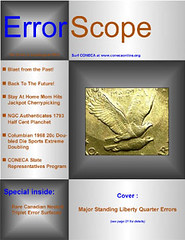 CONECA (The Combined Organizations of Numismatic Error Collectors of America) has released its latest bimonthly journal, The ErrorScope.
CONECA (The Combined Organizations of Numismatic Error Collectors of America) has released its latest bimonthly journal, The ErrorScope.
In this issue, Robert Knauss in his series of “In Search of Standing Liberty Quarter Varieties and Errors” shifts gears and discusses and illustrates some of the errors found on Standing Liberty Quarters.
Ken Potter also discusses and illustrates a 1968 Columbian 20 centavos piece that was submitted by R.A. Medina. This particular variety has some very attractive heavy doubling.
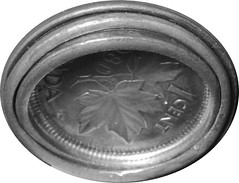 Roger Paulen has submitted an outstanding article illustrating a rare 1980 Canadian one cent coin, with a three – piece bonded broadstruck triplet.
Roger Paulen has submitted an outstanding article illustrating a rare 1980 Canadian one cent coin, with a three – piece bonded broadstruck triplet.
This issue also contains a nice review of some of the Doubled Dies from the Oregon and Minnesota Statehood Quarter Program. Also some detailed images of the 1920 Pilgrim Tercentenary Commemorative half dollar FS-901 showing the progression of the die crack from early die state through late die state.
CONECA President, Mark Lighterman, announces that CONECA will be celebrating the organizations’ 30th anniversary with a special double struck medal; order forms will be included in the September / October issue of ErrorScope.
Foe more information about CONECA, see: www.conecaonline.org
NEW YORK MANSION TO HOST NEWMAN II SALE
In response to my question about the next sale of material from the Eric P. Newman Numismatic Education Society (EPNNES), Maureen Levine writes:
The auction will be held November 15-16, 2013 at the Fletcher-Sinclair mansion, which is located at 2 East 79th Street and Fifth Avenue, New York, NY.
The 1897 mansion at 2 East 79th Street and Fifth Avenue has been home to the Ukrainian Institute of America since 1955. It looks like a lovely venue for an auction, a welcome change from the standard hotel ballroom.
The sale will be handled by Heritage Auctions. As announced in an ad on the back cover of this week's Coin World, the sale will feature "two cent pieces through early silver dollars, early silver condition rarities pedigreed to the "Colonel" E.H.R. green Collection, with an emphasis on quarters including Browning plate coins in the Bust Quarters series, half dollars and silver dollars.

For more information and images of the mansion, see: www.ukrainianinstitute.org
HARVEY STACK ON FORD, FRANKLIN, AND FALSE GOLD
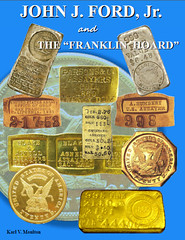 I enjoyed last week's E-Sylum and the item about John
Ford and Paul Franklin.
I enjoyed last week's E-Sylum and the item about John
Ford and Paul Franklin.
It was surprising to me , though it was reported earlier, discussed widely for almost 50 years, that the ANA hearing, and testimony received by such as Painter, Merkin and others, in which Ford presented a huge explanation of what he discovered about the series of the Early Assay office pieces in Proof, and the fact that the elite committee who heard the case, could not decide if the coins were genuine, were they counterfeited by someone or was it a discovery that has been dammed.
The case I refer to is the Garland charges that the ANA conducted the hearing for. They finally determined that the Garland Coin, (the one which was the subject of the hearing, was not a 'PROOF' nor a 'SPECIMEN STRIKING" but left the subject of Genuineness UNANSWERED.
The same group of critics who was downing the Assay office pieces, also took shots on items that were not in the Guidebook, or were in, and then removed, and then accused the same perpetrators of making or fabricating these.
To the best of my knowledge, when these were first marketed, they were checked for alloy and composition to be correctly stated as to what they were in quality or fineness.
The tests, which I saw, but do not have in my files, were done by several elite metallurgical laboratories at the time, which included but not limited to the Dupont Laboratory, MIT laboratory, and the U.S . Office of Weights and Measures, and the Department of Minerals .
All felt that the items were if the fineness , quality and had the characteristics of the area the gold was mined or was later assayed and stamped on the pieces.
 If one is to argue the case, the early Ford presentation, numbering
hundreds of pages, (as I remember it ) was not included in the
rebuttal, but from what I read John Kleeberg did not do a full
condemnation of the pieces, and spent a lot of time on the Mexican
bars.
If one is to argue the case, the early Ford presentation, numbering
hundreds of pages, (as I remember it ) was not included in the
rebuttal, but from what I read John Kleeberg did not do a full
condemnation of the pieces, and spent a lot of time on the Mexican
bars.
In my opinion , a report as detailed as this book, should have given the Ford information, which was argued , refuted but never determined to be incorrect when discussed in the 1960s, when John was alive and able to explain and refute some of conjectures found in his REPORT AND TESTIMONY.
In my opinion, the book with all its documentation reproduced was an attempt to vindicate Paul Franklin, who was well known to me as an associate of John Ford, in the sense of seeking info for John, and a poor attempt to pin "all foul play" on John.
If John was alive today, I feel he could have and would have refuted or logically explained what the "letters" said (both his and Paul's) and the poor case the opposition prepared against both in the early 1960's and still simmers in today's literature.
For those who would like to know, Werner Amelingminer, was a friend of John Ford, who collected somewhat, but was generous, though shared with John some of the deals that Werner helped John finance . I feel some credit for care and deep numismatic study and examination should be given to some of the alleged clients for the questionable coins and bars, i.e. Wayte Raymond, F.C.C. Boyd Mrs. Norweb, Stack's and the curators of the Smithsonian, who would have had the skill to question , study and determine the origin of these numismatic items.
Fred Werner, was an active Long Island Dealer, and sometimes got coins from John to sell to his clients, take some to shows to try to "make a buck" and was a somewhat well rounded numismatist in his own right. We had many smaller numismatists who made a living from getting merchandise from one source and selling it to another during the 1950's through the present day, in the New York Area.
The reviews you published were good for the matter to be reviewed by skeptics and put to rest. I respect the Harry Riesenberg use of the Mexican items to glorify and make a movie, but is that a source of argument or imagination?
To read the earlier E-Sylum article, see: BOOK REVIEW: JOHN J. FORD AND THE FRANKLIN HOARD (www.coinbooks.org/esylum_v16n26a07.html)
THE BOOK BAZARRE
NOTES FROM E-SYLUM READERS: JUNE 30, 2013
1811 Half Cent 2-Star Die State
In his review of the catalog of the Tettenhorst collection of half cents, last week Alan V. Weinberg wrote:
It is supposed to be a complete variety collection of half cents but I noted a blatantly missing 2 star diebreak 1811 half cent.
Bill Eckberg writes:
The 2-star break is not a variety. It is an intermediate die state of the 1811 C1, between the "perfect die" and the "4-star break." Tett did have a 2-star break, which was sold with the Davy collection of errors and die state and other non-"A" coins.
To read the earlier E-Sylum article, see: MISSOURI CABINET OF HALF CENTS CATALOG AVAILABLE (www.coinbooks.org/esylum_v16n26a13.html)
A Fore Letter Typo and Other Correcshuns
The introduction to an article last week was supposed to read
This article from London's Daily Mail discusses a crude counterfeiting operation recently shut down by police. -Editor
The wrong vowel made its way into the word. Greg Adams was the first to comment, writing " Interesting typo… But quite appropriate".
Steve Rush writes:
Your note on London counterfeiters being shit down by police brought a smile to my face early on a Monday morning!
Well, it was a crude counterfeiting operation. Glad they didn’t film it for reality TV…. Several others readers caught this too, including Larry Dziubek, Tom Sheehan, William Mills, George Huber, and David Sundman. Paul Schultz calls out a numismatic error in the newspaper article - see his note in another article in this issue of The E-Sylum,
To read the earlier E-Sylum article, see: LONDON COUNTERFEITERS PAINTED FAKE LEAD COINS (www.coinbooks.org/esylum_v16n26a23.html)
Joe Boling pointed out another oversight. He writes:
You probably should have corrected Howard Berlin's "forward" to "foreword."
Sorry I let those slip. The forward/foreword mixup is a common one.
To read the earlier E-Sylum article, see: HOWARD BERLIN REMEMBERS DICK DOTY (www.coinbooks.org/esylum_v16n26a11.html)
And here's a minor correction submitted by Fred Weinberg about the fabulous U.S. half cent he bought in Europe. He writes:
I just found out that I bought the coin in the first quarter of 1977, not 1975.........
To read the earlier E-Sylum article, see: DISCOVERING THE FINEST 1794 HALF CENT, HIGH RELIEF HEAD (www.coinbooks.org/esylum_v16n26a14.html)
Karl Kabelac writes:
In the press release for the 20th edition of Paper Money of the United States which appeared in last week's issue of The E-Sylum, I believe the end date for the 14,348 national banks listed in the book should be 1935, not 1929. (I see it is given as 1935 in my copy of the 19th edition.)
To read the earlier E-Sylum article, see: NEW BOOK: FRIEDBERG PAPER MONEY OF THE U.S. 20TH EDITION (www.coinbooks.org/esylum_v16n26a04.html)
Leather-Bound Edition of Tohv Estonian Book
Joe Boling writes:
 Last week you mentioned Allan Tohv.
Allan Tohv donated a leather-bound edition of his 2011 Estonian book to the International Bank Note Society library. Since that is now resident at the ANA library, that's where I delivered the book. I also asked Allan to sign it when I received it, something he said was not a common European practice and he was not comfortable doing. But he did it. Unfortunately, since it is a non-standard binding (one of 25, as I recall), and signed, the ANA probably has it in the rare book room and it can't circulate.
Last week you mentioned Allan Tohv.
Allan Tohv donated a leather-bound edition of his 2011 Estonian book to the International Bank Note Society library. Since that is now resident at the ANA library, that's where I delivered the book. I also asked Allan to sign it when I received it, something he said was not a common European practice and he was not comfortable doing. But he did it. Unfortunately, since it is a non-standard binding (one of 25, as I recall), and signed, the ANA probably has it in the rare book room and it can't circulate.
To read the earlier E-Sylum article, see: NEW BOOK: ESTONIAN COINS AND BANKNOTES (www.coinbooks.org/esylum_v16n25a03.html)
Query: DeAndrea Book on Silver Coins
Dave Ginsburg writes:
Is anyone familiar with the book "Silver Coins: Where Did They Go and Why" by Vincent F. DeAndrea (1984)?
Dr. DeAndrea was an economics professor at Quinnipiac University and I'm interested in finding out what time period his book covers (in case it covers the mid-19th Century).
The Worst Craft Idea Ever
It's non-numismatic, but Gar Travis forwarded this item sure to scare the bejesus out of us bibliophiles. It's a link to a video for a craft project involving the ghastly mutilation of books. I couldn't bear to watch it.
To read the complete article, see: The Worst Craft Idea Ever [Updated] (www.buzzfeed.com/catesish/the-worst-craft-idea-ever)
On National Savings Systems Scrip
Eric Schena writes:
Thanks for posting the National Savings Systems scrip ad from David Klinger - I had never seen that before and it is the first thing I have ever encountered that relates to how they were used. The only other thing I've run into on them is a Library of Congress acquisition listing for a pamphlet that John Byars forwarded my way. I think I may have to head downtown to the LoC and see if I can look at that pamphlet.
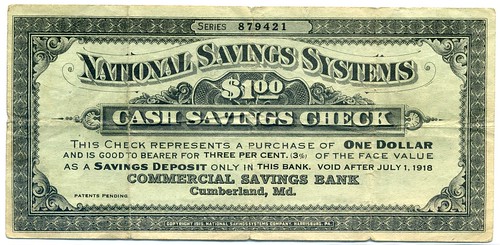
To read the earlier E-Sylum article, see: MORE ON CASH SAVINGS CHECKS (www.coinbooks.org/esylum_v16n26a08.html)
Susan McMillan Proclaimed ANA Summer Seminar Dean
At the first week banquet, the students, staff, and faculty of Summer Seminar installed Susan McMillan as Summer Seminar dean. The proclamation follows. She was obviously pleased by the action. Virtually every attendee signed the accompanying authentication document - it was covered face and back.
Susan McMillian
is recognized for promoting fellowship
and encouraging fun
while guaranteeing
learning and scholarship.
By consent and demand of
students, faculty, and staff,
she is hereby installed as
Summer Seminar Dean
and is from this date entitled to
all rights, privileges, and recognition
appertaining thereto.
Proclaimed this 27th day of June 2013.
MORE ON VIRGIL MCKNIGHT HANKS, JR.
David Lange writes:
Dan Hipple of the Pacific Coast Numismatic Society provided some additional facts. Hanks joined the PCNS on July 28th, 1961 but dropped his membership two years later. He rejoined sometime afterward, and he was already a member when I (DWL) joined in 1982.
Dan also found the following obituary, though I don't know the source.
V.M. Hanks, Jr., a well-known press and commercial photographer for nearly 40 years, died Tuesday of pancreatic cancer at his home in San Francisco. He was 76.
A descendant of Abraham Lincoln, Mr. Hanks was born in Decatur, Ill., in 1921. He attended Eureka College in Eureka, Ill., before joining the U.S. Marine Corps as a combat photographer in 1943.
Mr. Hanks saw action at Guadalcanal and, while recovering from malaria at a military hospital in Klamath Falls, Ore., he met and married Nadine Palmerton, who was a reporter for a newspaper in Klamath Falls.
In 1947 the couple moved to San Francisco.
During the next four decades, Mr. Hanks served as a visual diarist for the city, photographing heads of state, visiting dignitaries and numerous other celebrities.
In the '50s and '60s, he was photographer of record for many of San Francisco's major hotels and his work appeared frequently in local magazines and newspapers.
A talented designer with a passion for numismatics, he was involved in the design of commemorative medallions celebrating various anniversaries of the Golden Gate Bridge, the cable car and the San Francisco Mint.
He was a member of the Saints and Sinners fraternal charitable organization, the Disabled American Veterans, the American Numismatic Association and the San Francisco Coin Club. He was also a past member of the Bohemian Club.
In the late 1970s, he and his wife travelled extensively, photographing national mints and coins of numismatic interest throughout Europe, Asia and Latin America. Nadine Hanks died in 1984.
To read the complete obituary, see: OBITUARY -- V.M. Hanks, Jr. (www.sfgate.com/news/article/OBITUARY-V-M-Hanks-Jr-2833284.php)
To read the earlier E-Sylum article, see: VIRGIL MCKNIGHT HANKS, JR. (www.coinbooks.org/esylum_v16n26a15.html)
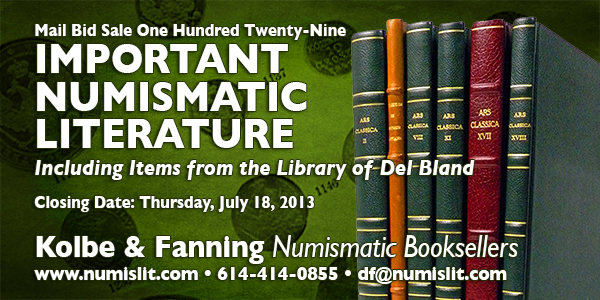
NATIONAL MARITIME MUSEUM MERCATOR MAP MEDALS
Joe Boling writes:
Perhaps the English manufacturer of the modern Mercator Medal whom Alan Weinberg was trying to remember was Pinches - they have done that kind of work.
I had a feeling that Tony Lopez's Drake Map Medal "must be" a recent reproduction, but I wasn't able to make that call for sure, since I don't know the diagnostics.
I believe that the modern version mentioned by Alan Weinberg were produced by the National Maritime Museum, which apparently owns the origingal that he remembers selling for $50,000. These medals were discussed in an earlier E-Sylum:
THE MERCATOR MEDAL OF DRAKE'S WORLD CIRCUMNAVIGATION
(www.coinbooks.org/esylum_v13n20a23.html).
An example of that reproduction with its box is shown here:
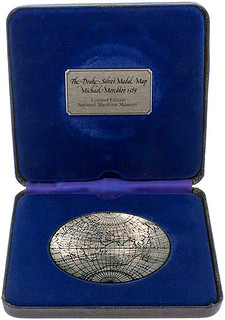
To read the complete page, see: The Drake Silver Medal Map (www.24carat.co.uk/frame.php?url=1989michaelmercator1589sirfrancisdrakemapsilvermedalion.html)
I'd note that both the design and the weight of Tony's piece differ significantly from those of this reproduction. The design of his piece seems to match that of this one from the NMM collection (http://collections.rmg.co.uk/collections/objects/37447.html), although even then the weights differ.
Rulau lists this as Rulau E8 with comments:
"The weight of the known specimens varies. Two specimens in the British Museum weight, respectively, 16.84 and 19.43 grams. The other known specimens weight 18.0, 18.39, and 27.46 grams, respectively. A marvelous 30-page booklet devoted entirely to this medal was written by Humberto F. Burzio in 1955, published in Buenois Aires, entitled La Medalla Cartografica de Francis Drake."
The copper medal shown by Alan is one of my favorite medals. The white metal version is Rulau E9 (75mm) or E10 (51mm). As Alan notes, the bronze version is unlisted by Rulau. Alan's seems to be the 75mm version.
These medals are unsigned and undated, but typically ascribed to the British medallist Sir Edward Thomason. Based on the features shown in the maps, Rulau dates the large one to circa 1815 and the small one to 1802: "The United States is shown as it was just after 1800 (Washington, D. C. founded) but before 1803 (Louisiana Purchase)."
I particularly like a chain of islands in the Pacific labeled as Owyhee (say it aloud a few times). That seems not to have been an error on the part of the medalist, but rather the preferred spelling in use at the time.
I spent several years looking for fairly nice matching sets of both sizes, then got them framed for hanging.
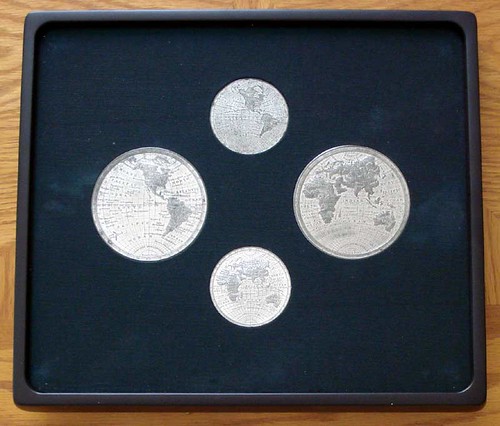
To read the earlier E-Sylum article, see: MORE ON MAP MEDALS (www.coinbooks.org/esylum_v16n26a20.html)
DORR & BREWSTER INFORMATION FOUND
Justin Perrault writes:
In the last issue of The E-Sylum, Mr. Tom Rigney was seeking information on the Dorr & Brewster partnership. Attached is an except I came across regarding that business partnership, and a bit of their background info, buried in a volume of Michigan State Historical Collections (Volume XXVIII of the Michigan Pioneer and Historical Society), published in 1900. I hope that it is of some help.


Tom Rigney writes:
That is certainly more information than I had been able to find on my own. Please forward my appreciation to Justin. It seems there had been an earlier association between Melvin and William Brewster around 1817 and how this note is signed by both, prior to the business partnership with Josiah Dorr in 1825.
Interesting stuff about these associations in the early days of the city's beginnings . I was thinking that William Brewster may have come from the East as well and may have some history with the founding of Brewster NY-CT. Both Dorr & Brewster had descendants traced back to the Mayflower.
To read the earlier E-Sylum article, see: QUERY: DORR & BREWSTER INFORMATION STILL SOUGHT (www.coinbooks.org/esylum_v16n26a21.html)
QUERY: PAPERS OF CHIEF ENGRAVER WILLIAM KNEASS SOUGHT
Daryl Haynor writes:
Do papers of Chief Engraver William Kneass exist, and if so where are they located? There exist Kneass family papers from 1835 - 1878 at the Historical Society of Pennsylvania. Those papers generally include those of his son Samuel Honeyman Kneass, and Samuel's family.
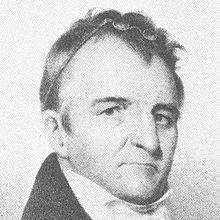 William Kneass (/ˈniːs/ niece) (September 25, 1781 – August 27, 1840) was the second Chief Engraver of the United States Mint from 1824 until his death in 1840. Kneass is credited with designing the "Classic Head" motif, which appeared on numerous denominations of American currency, including the gold Quarter Eagle ($2.50) and Half Eagle ($5.00) gold pieces from 1834-1839. He also modified John Reich's "Capped Bust" design on the half dime through half-dollar from the years 1829-1837. Additionally, Kneass utilized his modified Capped Bust for the rebirth of the half-dime in 1829.
William Kneass (/ˈniːs/ niece) (September 25, 1781 – August 27, 1840) was the second Chief Engraver of the United States Mint from 1824 until his death in 1840. Kneass is credited with designing the "Classic Head" motif, which appeared on numerous denominations of American currency, including the gold Quarter Eagle ($2.50) and Half Eagle ($5.00) gold pieces from 1834-1839. He also modified John Reich's "Capped Bust" design on the half dime through half-dollar from the years 1829-1837. Additionally, Kneass utilized his modified Capped Bust for the rebirth of the half-dime in 1829.
On January 29, 1824, Kneass was appointed Chief Engraver of the United States Mint. During his tenure as Chief Engraver, he oversaw production of gold coinage, and circulating coinage.
In 1830, Kneass redesigned the quarter, and in 1834, redesigned the gold coinage. He also introduced a new Liberty head on the half dollar, a design that was modified several times over the next two years. In 1835 Mint director Samuel Moore wrote of him: "Mr. Kneass, our present engraver ... is an acceptable, popular and very useful Officer, perhaps one of the most rapid in execution in the U. States. I do not know whether another could be found, whose celerity in his profession could have sufficed to furnish all the dies we have necessarily employed within the last five years."
On August 27, 1835, Kneass suffered a debilitating stroke that left him paralyzed on his right side. Once second engraver Christian Gobrecht was hired, he did most pattern and die work until Kneass died in office on August 27, 1840. Kneass was succeeded by Gobrecht as Chief Engraver on December 21 of that year.
To read the complete article, see: William Kneass (en.wikipedia.org/wiki/William_Kneass)
THE BOOK BAZARRE
AUCTION BIDDING: STAY IN THE ROOM
Sometimes the bidder in the room makes the final decisive move.
That happened at a Larchmont, N.Y. sale of antiques and fine art covered by our very own managing editor, David Smith. The winning bidder was there in the room, fighting for a German surrealist masterpiece that was found wrapped in a sheet under a bed during an estate call. The damaged but mostly intact painting was by Richard Oelze and was painted in 1935. The guy in the room almost walked away, but he didn't.
As David witnessed the action first-hand:
"Bids bounced back and forth between the telephones, the Internet and a gentleman standing in the rear of the auction hall as the lot cleared the $50,000 mark. [The auctioneer] jumped the bid increments to $5,000 advances with no sign of slowing down, and as the lot approached the $100,000 mark, she jumped to $10,000 advances. At $200,000, competition had narrowed to a single phone bidder competing with the gentleman standing in the rear of the gallery. The gentleman snapped his hand in the air at $300,000 and the phone bidder took a moment to hit the lot at $310,000.
The bidder in the gallery quickly hit the painting at $320,000; yet the phone bidder came right back at $330,000, causing the bidder in the room to briskly turn and walk out of the gallery and head for the door. Halfway across the lobby, he turned back and abruptly motioned that he was back in at $340,000, with what turned out to be the final uncontested bid. The painting realized $414,800, inclusive of premium."
To read the complete article, see: Long Lost Painting By Oelze Brings $414,800 at Clarke’s (antiquesandthearts.com/news/2013/06/25/long-lost-painting-oelze-brings-414800-clarke-s/184717#.Uc8j0_mNqXg)
A WWII AVIATION SHORT SNORTER
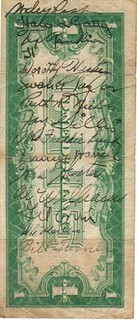 Serendipity struck short snorter buff Tom Sparks in April. He was approached by Marilyn Wheeler, daughter of late Florida coin dealer Clifford H. Benjamin, Sr. She had inherited a snorter from her dad in the shape of a Series 1928A Silver Certificate. It was not one from World War II. Rather, it was signed by some heavy hitting U.S. aviation pioneers, both men and women—and an Australian.
Serendipity struck short snorter buff Tom Sparks in April. He was approached by Marilyn Wheeler, daughter of late Florida coin dealer Clifford H. Benjamin, Sr. She had inherited a snorter from her dad in the shape of a Series 1928A Silver Certificate. It was not one from World War II. Rather, it was signed by some heavy hitting U.S. aviation pioneers, both men and women—and an Australian.
Marilyn stumbled over her snorter recently. She recalls her mother giving her the note in its plastic case when the two were sorting dad’s possessions after his death in 2004. She popped it in a drawer where it remained until its rediscovery. This prompted her to call in the cavalry in the shape of Tom Sparks.
The signatories are: Wiley Post, Harold Gatty, Tex Rankin, [aborted Harold Gatty signature], Dorothy Hester, Swanee Taylor, Ruth R. Nichols, Fay Gillis, Mrs Freddie Lund, Frances Harrell, Ken Hunter, Al Williams, Gil Ervin, ?H.C. Martins?, and Bill Turner.
All signatures have been verified by Randy Thern of Signatures in Time. At least 11 were top pilots and one a superb navigator. The backgrounds of two could not be verified.
The signature of Frances Harrell places an upper date on the snorter’s age. Frances was killed during the Cleveland Air Races on Aug. 5, 1934.
This age limit gives the Benjamin-Wheeler snorter an important place in snorter history. It links the use of snorters in World War II with their origins among Alaskan Bush Pilots of the 1920s.
It is also a rarity. Few snorters have surfaced from outside Alaska prior to World War II. Yet, presumably, the tradition spread to other sectors of North America’s fledgling aviation industry. Of their nature pioneering pilots were highly mobile. Some bush pilots tried their hands at barnstorming. Some barnstormers went bush.
To read the complete article, see: Post Leads Names on Short Snorter (www.numismaster.com/ta/numis/Article.jsp?ad=article&ArticleId=26981)
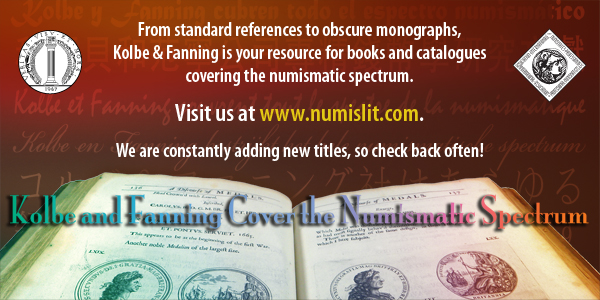
LEAD COUNTERFEITS, MAGNETS AND MAKING ELECTROTYPES
Paul Schultz calls out a numismatic error in a newspaper article quoted in last week's issue of The E-Sylum. He writes:
A little problem with the story on the London counterfeiters. Lead is not magnetic, even though the article states that the coins are lead and are magnetic. Somebody got it wrong in the original article. Furthermore, the painted coins would probably not have the proper electrical conductivity or other properties either.
By the way, electrotype creation is a form of plating, and the art/science of plating is usually underestimated by most who have never dealt with it. The common perception is you take a few items, throw them in a bucket of chemicals with an electric current applied, and a few hours later you get a perfect smooth coating. Nothing could be further from the truth, which is why people have spent decades developing chemical formulas and procedures for plating.
I spent a large part of my professional career in plating, but I would hesitate to publish the extensive details necessary to make electrotypes. Although the electrotypes themselves are rather easy to detect as copies, a nearly identical plating process can be used to make counterfeit dies from original coins, and those dies can then be used to strike pretty good counterfeits. Although the concept is simple, the devil is in the details.
Dick writes:
In answer to our reader's inquiry in last week's E-Sylum I sent him this data.
Electroforming is the same technology as electroplating.
My knowledge of electroforming and electrotypes came from the commercial application in the plants of Medallic Art Company. We made copper electrocasts of artist plaster models. From these artist 's models we made copper shells which would be placed on a Janvier reducing machine. Not only would it reduce the design it would cut a die from the relief on the copper shell. with great fidelity.
The copper shells were made in tanks large enough to accommodate models up to 18 inches in diameter. In addition to the copper tanks we also had separate smaller tanks for silver and gold for plating medals after they were struck. These were smaller because the medals were under six inches.
The technology has been written about, There are dozens of books on electroplating. Find one of these.
The numismatic monograph on the subject John Kraljevich and I are writing is still in research form. We need more examples -- and photographs -- of electrotypes. (We are interested in electroforms made in America in the 1800s and early 1900s. These includes plaques and art objects, not just coins and medals.)
As a suggestion, I am certain there is an electroforming firm in Denver. near where you live Ask them with the concept of writing an article . You could see all this in operation and answer all your questions.
You asked about the rod on the back of one electrotype you have. This was to hold on to it as it passed through the various steps in the process. It was removed to make the finished item
Any kind of lead or solder is satisfactory as a fill-in between two galvano shells. It has no function other than to make the shell more sturdy, and add weight.
Bronze powder must be used. It is pure copper. It must conduct the electric current as well as being the release agent. The surface to be deposited must be completely covered. All other surfaces must be covered with wax as a stop-off.
I am unaware of where you can buy bronze powders, perhaps an electroplating supply firm. I don't do any of this work myself. I hire the best professionals in the country. It is, as you learned, a very tricky business and not recommended because of the use of cyanide in the electroplating solution.
To read the earlier E-Sylum articles, see:
LONDON COUNTERFEITERS PAINTED FAKE LEAD COINS
(www.coinbooks.org/esylum_v16n26a23.html)
QUERY: HOW DO YOU MAKE AN ELECTROTYPE?
(www.coinbooks.org/esylum_v16n26a19.html)
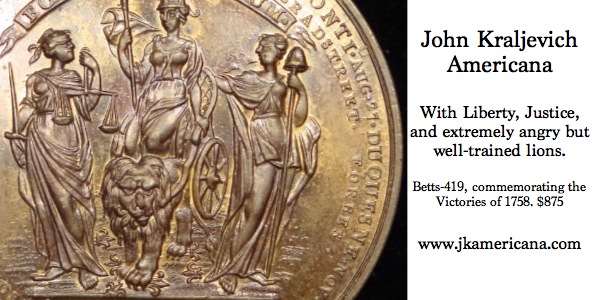
SOME NEW COIN DESIGNS: JUNE 30, 2013
Hungary Sándor Weöres Commemorative
This coin from Hungary "devoted to the 100th anniversary of birth of Sándor Weöres (1913-1989) noted Hungarian poet, writer, literary translator and scholar of the early 20th century." I like the unusual pose of the seated figure - I don't think I've ever seen a pose like this on a coin.

2013 Spain 10 Euro Cervantes Coin
 Pabitra Saha also sent the below image of Spain's new of Miguel de Cervantes coin. "At left are depicted the silhouetted figures of Don Quixote of La Mancha and Sancho Panza. The obverse portrays the likeness of His Majesty King Juan Carlos I." I don't like this one - those silhouettes remind me of the horrible flat cowboy on the Wyoming state quarter.
Pabitra Saha also sent the below image of Spain's new of Miguel de Cervantes coin. "At left are depicted the silhouetted figures of Don Quixote of La Mancha and Sancho Panza. The obverse portrays the likeness of His Majesty King Juan Carlos I." I don't like this one - those silhouettes remind me of the horrible flat cowboy on the Wyoming state quarter.

Lithuania 50 Litu coin
Here's a Lithuanian 50 Litu coin on the 2013 Presidency of the Council of the European Union. I can't make heads or tails of this flat, crowded design. What a mess!
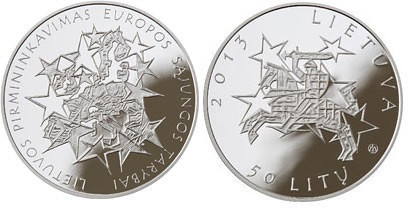
PROTESTS DRIVE BANK OF ENGLAND TO JANE AUSTEN
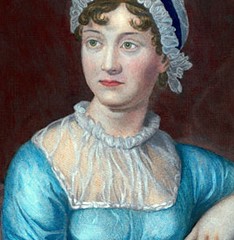 Jane Austen could be the face of the new £10 note, according to the retiring governor of the Bank of England.
Jane Austen could be the face of the new £10 note, according to the retiring governor of the Bank of England.
The author is "quietly waiting in the wings", Sir Mervyn King told the Treasury select committee, although a final decision will be taken by his successor, Mark Carney, who takes up the post on 1 July.
King provoked a storm of protest when he announced that the only woman to appear on an English banknote other than the Queen – the prison reformer Elizabeth Fry – would be replaced by Winston Churchill in 2015. Campaigners have threatened to take the Bank to court for discrimination under the 2010 Equality Act.
Historical figures were first introduced on British banknotes in 1970, since when there have been only two women: Fry and Florence Nightingale. The others have all been men, from William Shakespeare and Charles Dickens to composer Sir Edward Elgar and scientist Michael Faraday.
Caroline Criado-Perez, who is organising the legal action against the Bank, said she would not be "placated" by King's remarks. "He is still talking in conditionals and I am afraid that is just not good enough. It is not good enough in terms of the demands of the campaign and it is also not good enough according to the Equality Act … which, as we have been saying all along, is about needing to know that the decision-making process is fair and equitable."
More than 29,000 people, have signed a petition to keep women on English banknotes, damning Fry's relegation as "yet another example of how the establishment undervalues the contributions of women to history".
Churchill, who King has described as "a truly great British leader, orator and writer", will make his debut on the £5 note as planned from 2015. King added that once the Churchill notes are in circulation, Fry will continue to appear on the old £5 notes until they are phased out.
"Let me assure that there is no imminent demise of Elizabeth Fry on our banknotes and I think it is extremely unlikely that we will ever find ourselves with no women on our banknotes," King said.
To read the complete article, see: Jane Austen could grace £10 banknotes, Mervyn King says (www.guardian.co.uk/business/2013/jun/25/jane-austen-banknotes-mervyn-king)
BANKNOTES COOLER THAN THE BORING AMERICAN DOLLAR
One good way to judge a currency is by looking at how it trades on the foreign exchange markets.
A less boring way is to just see how it looks in your hand, all crisp and money-like.
From epic 19th century leaders to blinding color schemes, some of the globe's currencies use style to make up for a dearth in purchasing power.
Sure, the U.S. dollar is great. But the boring colors and lack of diversity (Every face is of a white male) makes it the most boring currency in the world.
So, here you have it: the world's coolest banknotes.
1. Icelandic krona
With a cartoonishly Nordic look, the krona is fun for the whole family
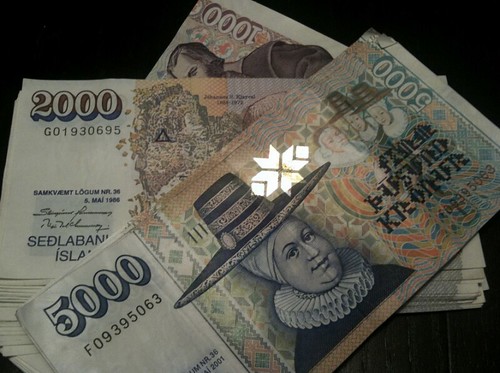
15. Bhutanese ngultrum
Stunning (plus honorable mention for best name).

To read the complete article see: 16 Foreign Banknotes That Look Way Cooler Than The Boring American Dollar (www.sfgate.com/technology/businessinsider/article/16-Foreign-Banknotes-That-Look-Way-Cooler-Than-4638998.php)
THE BOOK BAZARRE
SAINT-GAUDENS DIANA STATUE TO BE REGILDED
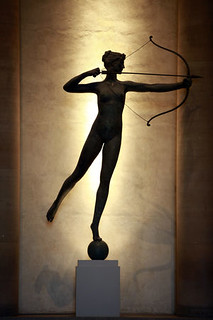 A once-golden statue of the deity Diana that formerly stood as the tallest point in New York will be refurbished by its current owners at the Philadelphia Museum of Art.
A once-golden statue of the deity Diana that formerly stood as the tallest point in New York will be refurbished by its current owners at the Philadelphia Museum of Art.
The 13-foot-tall sculpture by Augustus Saint-Gaudens depicts the hunting goddess poised to shoot an arrow. Conservationists are using a $200,000 private grant to regild the now faded artwork with 180 square feet of gold leaf.
"Diana is widely recognized as one of the great icons of our collection, but most people do not realize that the sculpture's gray-green surfaces once gleamed in gold," museum director and CEO Timothy Rub said in a statement.
The statue was first installed in 1893 as a weather vane atop the original Madison Square Garden in Manhattan. Standing on a 300-foot-high tower and fitted with "billowing drapery" to catch the wind, Diana became the highest point in the city, according to museum records. It was also the area's first statue to be lit at night by electricity.
After the entertainment complex was torn down in 1925, Diana was placed into storage. The Philadelphia museum acquired the statue seven years later; since then, she has stood at the top of a staircase in the museum's grand entrance hall.
The restoration project announced Thursday is expected to take about four months.
To read the complete article, see: Once-golden statue that stood atop NYC landmark will be regilded by art museum in Philadelphia (www.therepublic.com/view/story/c1c8c227397f481fba2009c2825e7f67/PA--Golden-Statue)
FEATURED WEB PAGE: LITHUANIAN COINS OF THE 1920S
This week's Featured Web Page is Lithuanian coins of the 1920s, from the World of Coins site.In the 20th century, the further back you go, the more common it is to find sprigs of oak leaves, ears of wheat, flowers and other vegetation used as ornamentation on a coin, so much so that it becomes almost a cliché. This Lithuanian circulation set, however, takes the usual suspects and depicts them with such artistic verve that it becomes a very stylish set.
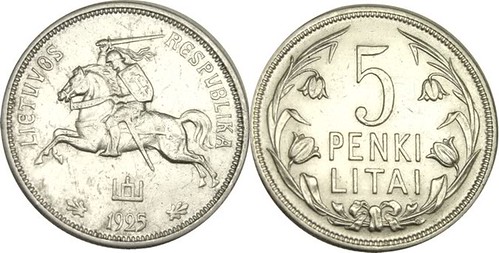
www.worldofcoins.eu/forum/index.php?topic=8971.0
